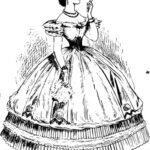
In the twentieth century, a few very impactful literary theories regarding voice and silence in the Western discourse were developed – the different waves of feminist theory and the theories of Michel Foucault. While each of the theories has its own unique areas of research, they yet share some fundamental equivalent points and correspond with each other. This essay will discuss the relations between the theories and will illustrate their similar and different manifestations in mainstream Hollywood cinema, which is an influential channel to transmit knowledge in Western society.
In his three masterworks – Madness and Civilization, History of Sexuality and Discipline and Punish – Foucault elaborates on the connections between knowledge and power; those who are in power determine the knowledge conveyed in the discourse, and by maintaining that knowledge in the discourse, they remain in power. This is essentially the basis of all waves of feminist theory: the discourse is dominated by men who only express their own masculine voice while silencing women, and by that, keeping their superiority in society over women.
Feminist theories look for ways to change this type of discourse, each wave in its own way, which means either integrating female knowledge into the existing discourse or creating a completely new discourse that consists solely of female knowledge (radical feminism). According to Foucault, suppressive power eventually originates resistance; feminism, by its nature, is therefore resistance to the silencing of feminine voice by men. From their basic core, Foucault’s theories and feminist theories are thus intertwined, even if, later on, they take their own unique course. One of the contemporary cultural fields, which embody the joint prevalence of the theories, is mainstream cinema and television.
In nowadays’ Western culture, the Hollywood entertainment industry has a profound impact on society. Movies and television shows are constantly being quoted in newspapers, magazines, websites, books and even in academic essays; people adopt phrases, clothes and behaviors of their fictional heroes and heroines, and discuss scenes and characters from their favorite shows in the workplace and at home. In fact, it is likely that even a person who does not watch television or go to the cinema at all would still be tremendously affected by this medium due to its huge indirect influences on him/her, such as dress codes, jargon, decorum, etc. Therefore, the Hollywood entertainment industry is a massive conduit of knowledge and, as Foucault determines, a highly effective mechanism to impose power. When examining who is in power of this enormous medium of knowledge, the theories of feminism and Foucault accurately prove the dominance of patriarchal systems – those in power in Hollywood are almost exclusively men.
According to a study examining the gender roles in the top 100 most popular films each year during 2007-2012, women’s representation in motion pictures on-screen and off-screen is abysmal. In 2012, only 28.4% of the characters in the most popular films were female, merely 27.5% of narrators were female and a measly 6% of the top-grossing films featured a balanced cast. The off-screen gender roles data reveals even a greater disparity; in 2012, only 20% of the producers were women, 12.2% of the writers were women and no more than 4.1% of the directors were women. These numbers establish the premise that men are in almost complete power over the Hollywood entertainment industry, which reflects the strong male-dominance knowledge conveyed in films. The study points out that women are over 4.5 times more likely to appear in sexy attire and 3.3 times more likely to appear partially naked than men; these stats are a clear indication of the objectification of women.
The study, therefore, substantiates the theories of feminism and Foucault: The film industry is part of the patriarchal system in which men infuse their knowledge to maintain their power. However, as Foucault specifies, power yields resistance. In the patriarchal film industry, this resistance attempts to take shape in the form of a feminist film made by a woman, which revolves around a female heroine, Zero Dark Thirty. Yet, even in this sort of movie, the male-dominant power and knowledge are still deeply imbued.
Zero Dark Thirty was released in 2012 and gained massive critical acclaim; it was nominated for five Academy Awards and won one for best sound editing, and was nominated for four Golden Globes and won one for the best leading actress, Jessica Chastain. The film features relatively unusual female-leading figures both on-screen and off-screen: the plot focuses on a female CIA agent who tenaciously chases information about the whereabouts of Osama bin Laden; the film’s director is a woman, Kathryn Bigelow. Presumably, the film is utterly feminist – a female director is responsible for the artistic vision of a story in which a heroine bravely drives the plot forward.
However, this type of Foucault-esque resistance to male power still swims in very patriarchal waters, and thus, the film is soaked with a masculine voice. A close analysis of a few scenes from the film divulges that it may not be as feminist as it initially appears.
The first scene of Zero Dark Thirty displays the interrogative torture of a terrorist by the CIA, which comprises men mainly; it includes five male CIA agents, one male terrorist and, the film’s heroine, agent Maya. Although Maya expresses enthusiasm to go back and interrogate the terrorist furthermore, during the intense torture, she is the only one who cringes and can barely partake in the interrogation. This conveys the sense that in spite of Maya’s relative decisiveness, she is still an inferior woman in a world of much calmer and more composed men.
In a later scene, it seems that Maya has developed a firmer character as she leads different interrogative torture of another male terrorist by herself with two other male CIA agents [minute 43:00]; however, right after this interrogation, Maya is alone in the toilet, breathing heavily as she tries to recollect her composure. Again, these scenes display a disproportionate gender ratio where the only female reveals some sort of weakness.
In a scene in which Maya rebukes her male station chief for refusing to chase a solid lead on bin Laden, he retorts, “You’re fucking out of your mind” [minute 80:00]; this statement aligns with Foucault’s theory that in order for the man in power to negate her, he categorizes her as being mad.
In a different scene, one CIA male executive makes a similar statement to another when Maya urges them to make a decision: “It’s her against the world” [minute 110:00]. In the following scene, a meeting of the CIA top brass takes place, which includes seven male executives and only one female, Maya [minute 111:00]; it indicates that even if Maya is a very capable female agent, she is yet just an abnormality in the system. After this meeting, the male CIA chief asks one of the male executives “what [does he] think of the girl,” to which he replies that “she’s fucking smart,” and the CIA chief concludes by stating that “we’re all smart” [minute 112:00]; this discourse is not a discussion about Maya’s capabilities but about Maya’s capabilities as a mere woman.
As illustrated, even in a film supposed to be feminist, there are many overt and covert subtleties of knowledge in the subtext, which still maintain the superior patriarchal system in power. There is no doubt that in Zero Dark Thirty, there is a feminine voice; however, it is at least partially silenced by classifying it as an anomaly. Maya is presented as a revered heroine, but she is just an exception in a world that consists mostly of men. It seems that Foucault’s theory of power and knowledge sadly proved to be correct, although it was certainly a worthy attempt to utter a different voice in the discourse, a female one.



